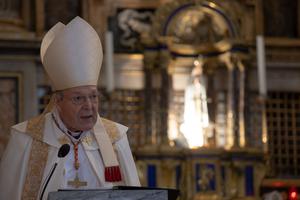Bishop Mulkearns, Accused of Sex Abuse Cover-Up in Australia, Dies
The bishop’s death prevents him from facing further scrutiny by Australian and Vatican authorities over his actions for knowingly covering up clerical sex-abuse of children.

BALLARAT, Australia — Bishop Ronald Mulkearns, who led the Diocese of Ballarat in Australia’s Victoria state from 1971 to 1997, died Monday at the age of 85. He had been accused of covering up sexual abuse of children in his diocese.
Bishop Mulkearns died April 4 at the Nazareth House Nursing Home in Ballarat after suffering colon cancer.
“Those who knew him personally will remember a man who was dedicated in his service over those years and, indeed, over the sixty years he served as a priest,” Bishop Paul Bird of Ballarat stated. “At the same time, Bishop Mulkearns himself acknowledged that he had made some tragic mistakes during his time as bishop.”
However, the bishop was also excoriated shortly before his death by fellow Australian Cardinal George Pell, who said at a February hearing before hearing before Australia’s Royal Commission that he could not think of another bishop “whose actions are so grave and inexplicable” regarding the sexual abuse of children by priests in his diocese.
Pell, the prefect of the Vatican’s Secretariat for the Economy, had said Bishop Mulkearns’ “repeated refusal to act” on the knowledge of priests sexually abusing children was both “indefensible” and “extraordinary.”
The cardinal said Bishop Mulkearns would be a candidate to face justice under the Vatican’s new tribunal in the Congregation for the Doctrine of the Faith, given his pattern of shuffling accused priests to new parishes.
Bishop Mulkearns was born in 1930 in Caulfield, a suburb of Melbourne, and was ordained a priest of the Archdiocese of Melbourne in 1956. He was consecrated a bishop in 1968 and appointed coadjutor bishop of Ballarat. He succeeded as bishop in 1971, remaining there until his resignation in 1997, at the age of 66.
The bishop was known to have moved Gerald Ridsdale, one of Australia’s most notorious abusers, between parishes for several years while being fully aware of the former priest’s abuses. Ridsdale is known to have committed more than 130 offenses while chaplain at Ballarat’s St. Alipius school in the 1960s—1980s.
Ridsdale was first convicted of charges related to child sex abuse in 1993.
In 2013, Australia established the Royal Commission into Institutional Responses to Child Sexual Abuse. The commission has held more than 30 hearings on institutions’ handling of sex abuse, including religious groups, sporting and youth institutions, and government institutions.
Bishop Mulkearns appeared before the commission in February via video, saying that “I certainly regret that I didn’t deal differently with paedophilia. We had no idea, or I had no idea, of the effects of the incidents that took place.”
Bishop Bird noted in his statement that Bishop Mulkearns had “expressed his sorrow for [his] mistakes in the evidence he gave to the Royal Commission in February.”
“The Royal Commission had foreshadowed a further hearing of evidence from Bishop Mulkearns. His death means that the Royal Commission and survivors will not be able to hear any further evidence that he might have given and this will be a disappointment to them,” Bishop Bird added.
Cardinal Pell was ordained a priest of the Ballarat diocese and served for a time as a consultor to Bishop Mulkearns.
At his hearing before Australia’s Royal Commission, Cardinal Pell said that Bishop Mulkearns concealed the reason for moving priests as Ridsdale to new parishes. He said the way Bishop Mulkearns had dealt with Ridsdale, was “a catastrophe for the victims and a catastrophe for the Church.”
Register staff contributed to this report.

















